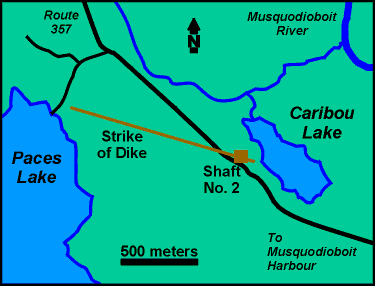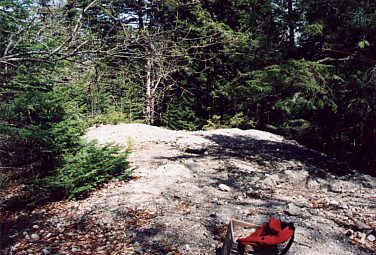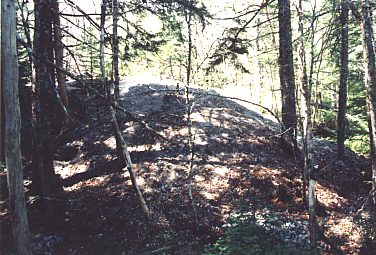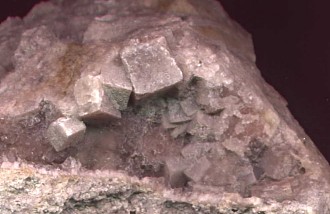

|
Introduction Nova Scotia is not rich in places to collect interesting secondary lead and copper minerals, and the Dunbrack Mine is one of the few localities where such minerals can be found. The Dunbrack Mine is located about 4.8 km north-west of the village of Musquodoboit Harbour, in Halifax County, Nova Scotia.

Figure 1: Map of the general area surrounding the mine shaft. History Float mineralization from the area was first found in 1888 by Mr. John Kerr. Although argentiferous lead drift was prospected for years after its discovery, it was not until 1909 that a regular deposit was found by Bessie and John Dunbrack. In 1909 and 1910, about 5 men were employed digging several surface pits and a shaft. The shaft was 20 m deep and at a depth of 18 m a tunnel was extended 91 m south. By 1915 mining operations had ceased. In 1916, Robert Ewing of New Orleans acquired the property and extended the underground workings. By June 1920 mining operations had again ceased. At some time a second shaft, 41 m deep, was excavated, with drifts at the 27 m level extending 33 m north and 33 m south. Between 1954 and 1958, a Mr. F. Hogan drilled 5 diamond drill holes. Noranda Exploration Company Limited investigated the property between 1980 and 1982. This investigation resulted in 3 diamond drill holes. All that remains today at the locality is a small partially overgrown dump heap, over an embankment, off the side of a road. The slope where the ore was pulled up the embankment is also still visible.

Figure 2: Springtime shot from the top of the
partly Geology The deposit is located in the central part of the Musquodoboit Batholith. The batholith consists of primarily leucomonzogranite. The deposit is described as a quartz-rich fissure vein and breccia zone. The thickness averages 1 m and the length at the surface is several hundred meters. Lead, copper, zinc, and silver were the primary metals recovered during mining operations.

Figure 3: Springtime shot from the bottom of the dumpheap. Mineralogy Minerals reported from the mine by Sabina include galena, chrysocolla, malachite, chalcocite, chalcopyrite, cerussite, quartz (smoky, rose), feldspar, and chalcedony. More recent reports list tridymite, tourmaline, fluorite, azurite, pyrrhotite, ilmenite, djurleite, digenite, sphalerite, pyrite, bornite, meneghinite, and pyromorphite. The pyromorphite is the most interesting mineral for collectors. However, good specimens of malachite and cerrusite have also been found. The Nova Scotia Museum of Natural History, has a specimen labelled cuprite. The author also has a couple specimens of cuprite. Finally, a blue mineral, common on the dumps, is assumed to be the reported azurite. A simple test with hydrochloric acid, however, indicates that this mineral is linarite, not azurite. In addition to the minerals listed here, recent investigations have revealed goethite and three unknown minerals. Visual ID of the three unknowns suggests aurichalcite, rosasite, and wulfenite. Cerussite Cerussite, while not as common as pyromorphite, can be found on the dumps without difficulty. Multiple habits can be found including slender needles, blades, and blocky crystals. Color varies from colorless to beige. Twinned crystals have also been found.
Chrysocolla Colorful masses of chrysocolla can easily be found on the dumps. Cuprite Crystals of cuprite to over 0.5 mm have been found. They form as groups of red octahedrons. They appear to be uncommon, however they may be overlooked due to thin coatings of malachite. The author's best specimen has about a dozen crystals in a quartz lined pocket with galena crystals. Fluorite Reported by MacMichael (1975). Galena Massive galena be be found on the dumps, however, crystals appear to be be very uncommon. The author has only found one specimen with crystals, and they are less than 1 mm along an edge. The galena from the deposit is argentiferous, and when the mine was operating, a small amount of silver was extracted from the galena. Goethite This mineral has not been reported from the mine before. Although no physical analysis of the mineral were performed, there is little doubt that it is goethite. It forms acicular sprays of very thin golden-brown blades. These balls grow on and in druzy, water clear quartz crystals in a pocket in jasper. Ilmenite Reported by MacMichael (1975). Linarite A massive light blue mineral is common on the dumps. Commonly thought to be azurite, this is actually linarite. Samples can be tested by simply applying some hydrochloric acid - azurite will bubble under such a test. The samples the author tested instead formed a white coating indicating linarite. Although uncommon, sharp edged, tiny microcrystals can also be found. These crystals are the typical darker linarite blue. It is assumed that the light blue massive material has formed a partial white coating due to weathering. Malachite Malachite staining is evident on a large proprotion of the dump rock. Nice pockets with botryoidal malachite can be found including balls of malachite to several centimeters in diameter. Tiny malachite crystals have also been found lining small cavities. One specimen in particular display beautiful green acicular sprays on quartz crystals. Pyrolusite Reported by MacMichael (1975).
Pyromorphite Pyromorphite reported by MacMichael (1975). Dickie (1978) mentions that it was reported by Von Bitter in an undated, unpublished museum report. Chatterjee writes that, 'Its presence as well formed crystals with quartz and tridymite, and also its association with unoxidized pyrite and meneghinite in meta-arkose suggest a primary origin." The mineral is quite common in the dumps and can produce some nice specimens of small size. Pyromorphite occurs commonly as brownish-yellow (caramel) crystals to over 1 cm in length. Less commonly, the pyromorphite is colorless, dark brown, dark green, or bright apple green. The dark green appears to be due to malachite inclusions and in one specimen forms attractive bands in the caramel colored crystals. The apple green specimens seem to be limited to tiny micro crystals. Many crystals are color zoned; often caramel colored with colorless ends. Some of the crystals are partially hollow, and others exhibit unusual terminations. While micro pyromorphite is common in the dumps, display specimens with larger crystals are difficult to find, and appear to be distributed unevenly throughout the dumps.
Quartz White quartz pseudomorphs after a cubic mineral (galena?) have been found on the dumps. They normally form groups of cubes, each up to 1.5cm along an edge. A couple of the cubes also exhibit octahedral modifications.

Figure 6: Quartz pseudomorphs after a cubic mineral. Figure 7: Quartz pseudomorphs after a cubic mineral. These pseudomorphs have not previously been reported from the locality. They appear to be uncommon, and the three known examples all can from one area of the dumps. However, the dumps have not been well sampled, and they may occur in other areas as well. Sphalerite This mineral appears to be uncommon in the dumps. One specimen shows a surface of dark reddish brown sphalerite with a few complete crystals. Unknown 1 A (slightly greenish) blue mineral forming needle-like crystals. The matrix is generally chalcocite or a similar copper sulphide. One specimen consists of a small spaces between cleavages of a chalcocite psuedomorph after galena. The unknown forms elongated crystals with what appears to be a triangular cross section. The crystals also appear to be narrow at the attachment with the matrix, and grow slightly wider towards the termination. Visual ID would suggest aurichalcite. Unknown 2 Similar to Unknown 1, the author has only seen one specimen of this unknown. It forms tiny acicular sprays that vary from white to pale powder blue. It is very difficult to distinguish from the white matrix, which is why it may have been overlooked. Visual ID would suggest rosasite. Unknown 3 Lustrous orange crystals to nearly 1mm. The crystals form steep rounded bipyramids. They are associated with the apple green pyromorphite and don't bubble in HCl. Visual ID suggests wulfenite or stolzite. Conclusion While the mineralogy of this deposit has been studied in the past, recent collecting has produced some unreported minerals. It is not known if past studies collected only on the surface, or if they sampled from within the dump piles. Further work will be necessary to identify a few unknown minerals found. References Chatterjee, A.K., "Comments on the Association of Tridymite, Pyromorphite, and Meneghinite from Dunbrack Prospect," Nova Scotia Dept. Mines, Report 77-1, pg. 99-102, 1977. Dickie, J.R., "Geological, mineralogical and fluid inclusion studies at the Dunbrack lead-silver deposit, Musquodoboit Harbour, Halifax County, Nova Scotia", unpublished B.Sc. Thesis, Dalhousie University, Canada, 1978. Friedlaender, C.G.I., "Tridymite in Mineralized Zone at Dunbrack, Musquodoboit River, Nova Scotia," Canadian Mineralogist, pg. 572, 1968. Kontak, D.J., "Mineralogical and Geological Studies of the Dunbrack Pb-Cu-Zn-Ag Deposit, Musquodoboit Batholith, Southern Nova Scotia," Report of Activities, pg. 73-86, 1996. MacMichael, T.P, "The origin of the lead-zinc-silver ores and lateration of the surrounding granite at the Dunbrack Mine, Musquodoboit Harbour, Nova Scotia", unpublished B.Sc. Thesis, Dalhousie University, Canada, 1975. Sabina, A.P., "Rocks and minerals for the collector : Northeastern Nova Scotia, Cape Breton, and Prince Edward Island", Geological Survey of Canada, Paper 65-10, 1965. |
